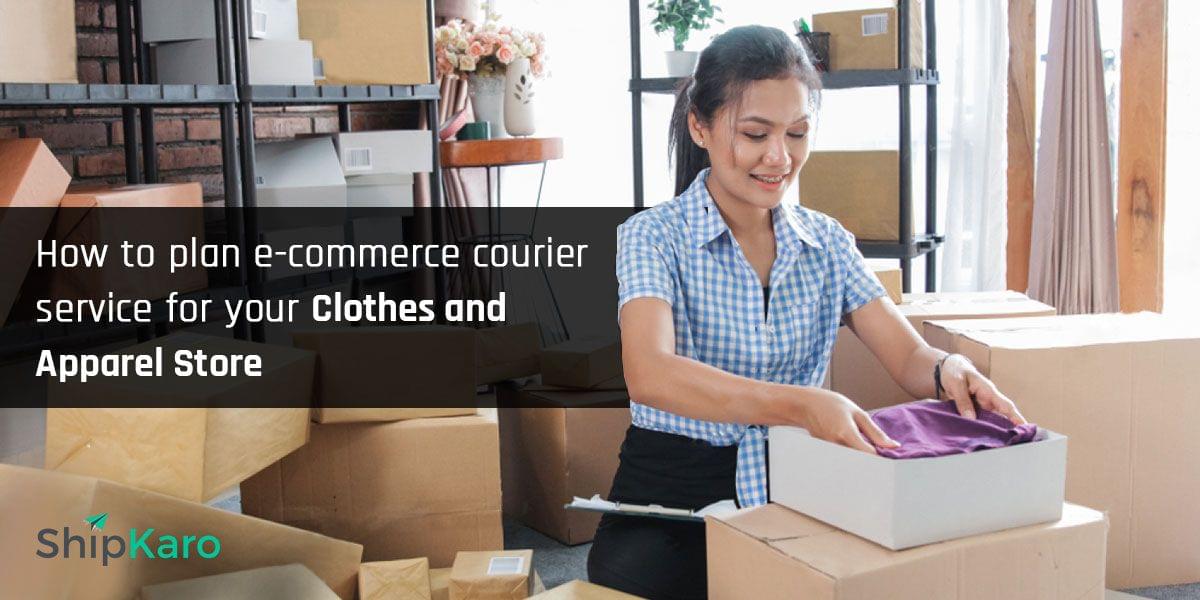Did you cut the ribbon for your e-commerce clothes and apparel store just recently? No wonder why! Well, smart entrepreneurs have fixated on the popularity of ecommerce niches. They have already started reaping the benefits through successful logistics and supply chain optimization.
Choosing to sell clothes online is a popular choice amongst beginners and pro e-commerce entrepreneurs. It is because an online apparel store is driven by fashion, has a universal appeal and is comparatively easier to customise.
So now that you are a business owner of an online apparel store, you need to get familiar with what works in the e-commerce world and what does not.
Firstly, just because your business segment is popular and profitable does not mean success is a low hanging fruit. Increased popularity leads to increased market competition and tougher logistics challenges.
Secondly, there is a dime a dozen online apparel stores and more are just lined up to bring something new every day. Hence, you need to ensure that your brand stands out from the millions of others in the market. And to do so, you need to pitch high-quality products and services including excellent supply chain optimization.
Supply chain management has a role in the entire play of brand building. If you are new to the e-commerce industry or looking forward to understanding how to plan e-commerce courier service for your clothes and apparel store than this post is for you! In this blog, we will take you through some important steps that will strengthen your supply chain and courier service.
#1 Have your shipping strategy in place: Having an effective supply chain strategy is one good start to boost your online apparel store. You might have noticed several brands taking a simplistic approach like offering free shipping. But in reality, most of the successful merchants take a strategic approach to differentiate their brand from others and increase profit margins. Strategic shipping requires coordination between team members within the organisation at multiple levels, all the way from your marketing team to your logistics partner.
A clear supply management strategy is a fine balance between being attractive to the customers and making business sense for the seller. So how do you achieve this? Let’s see some easy-to-apply options:
- Free shipping: Wouldn’t freebies attract your customers? Well, any day! To capitalise on this advantage, you and your ecommerce courier service provider can absorb the cost of delivering the product. You can also raise the prices enough to cover the cost. The simplest way to balance this is to set a minimum amount shopped before shipping becomes free. This tactic helps increase average order amounts and help bring up profits against offset shipping costs.
- Charge only for what you pay: Let’s say an actual cost of shipping a dress to one of your buyers is Rs. 50. As part of a good logistics strategy, you need to ensure that you only charge your customer Rs. 50 and nothing more than that. This means that as a seller you only charge your customers what it takes to ship them the product. This option contains higher chances of attaining a breakeven between the shipping costs incurred and those paid for by the customer.
- Flat rates: Good supply chain optimisation includes offering flat rates to your customers intermittently. Other variations of this option include rates based on package weight or total purchase amounts. A good e-commerce courier service provider can help you with the correct packaging. From time to time, you will need to figure out what flat rate works well for your online clothing and apparel store as well as for your customers.
#2 Give equal importance to reverse logistics: Just like any other business your online apparel store will also get some product returns. (use simpler terms wherever possible). This is referred to as reverse logistics and is one of the most fundamental operation challenges that most companies face in their supply chain management. Customers of your online clothes and apparel store may return the order if they receive a wrong size or if they are not satisfied with the quality, colour, print or the overall product.
There is a volume of items that are continuously returned by the customers. The cost to the company for these returned deliveries is also substantial. Hence even a small percentage of all delivered items when returned, can translate into high volumes and add to the logistics cost. This problem can seem to magnify during the peak holiday season, festivities and offers. One of the best ways to avoid minimal reverse order placements is to be highly transparent about what you display on your portal. Clear images, specific details about the material, sizes and colour options can help your customers choose accurately. You can also provide a reference size chart to give them a better idea about what to expect.
Reverse logistics remains an important aspect of the supply chain. Any supply chain set up would be incomplete without planning and implementation in this area.
An ideal and effective reverse management process can have clear benefits in terms of customer satisfaction as well as in storage and distribution costs. Let’s have a look how!
- Improved customer satisfaction: In order to improve customer satisfaction, you need to be conscious about defective products. If your customers realise that your company considers their preferences, they might return to your store for future purchases. This process can build a customer base and loyalty. The feedback from your loyal customers can help you in improving your logistics processes. You can use their suggestions to understand the reasons for product returns.
- Reduction in costs to the firm: Most of the times, unsold items reach their place of production due to reverse orders. Ideally these items can be taken apart, reassembled and recycled to produce something else. However, in terms of apparels, recycling is hardly possible. Seldomly, readymade clothes are altered to something else. So what can be done to reduce reverse order costs? Well, one of the common uses for apparels returned by customers is internal use. Using returned clothes internally amongst staff members allows you to cut costs by saving expenses associated with recycling a product. You can also store the products and then display them once again by announcing seasonal sales, festive offers and so on. An ideal logistics strategy should help you reach a breakeven between production and selling cost when orders fail.
#3 Follow best practices: Let’s consider where you are placed currently. You have an online clothing and apparel store that is performing fairly well. Your profit margins are good, your customers are satisfied and you have a sorted supply chain with a reliable e-commerce courier service partner. So what remains now? Well, now you need to focus on sustainability, which is attainable through some best business practices. The following applies to both sellers with big and small businesses and can help them achieve supply chain success.
- Flexibility: Keep your supply chain less complicated and flexible. This will give you the scope of expansion in workstations and temporary staff during times of increased work such as promotions and festivals.
- Order Auditing: You don’t want to create blunders by delivering the wrong clothes to your customers, do you? The key element of a good logistics process is ensuring that your customer receives the right order in the promised time. An audit process ensures that order accuracy is maintained throughout the supply chain. You can choose to have an automated system to ensure that this happens.
- Right Packaging: You can’t ignore this singular aspect. This includes sending out attractive packages to your customers just like the apparels it contains and ensuring the safety of the product. At the same time, your packaging should be cost-effective. It shouldn’t be a burden on your logistics chain.
- Accurate Inventory Management: Any business will have ups and downs in terms of high sales and low sales periods. In either case, there needs to be an accurate measure of inventory in stock and this needs to be maintained to ensure that all orders are fulfilled at the right time. A reliable e-commerce partner can help you achieve this.
The Bottom Line: Yes, you have successfully established your online clothing and apparel store. But what next? You need to strengthen your supply chain and build deeper bonds with your e-commerce courier service provider.
Efficient delivery service can be like a game changer for your business. It can make or break the relationship that you are trying to establish with your customers. The biggest pain point for you can be a good third-party courier service provider. Because despite a decent product and competitive prices, you may easily spot abandoned carts if your apparel delivery is not quite up to the mark.
Make sure you keep a close watch at your logistics process. tie-up with a reliable shipping aggregator like ShipKaro that can make the entire process easy for you. ShipKaro assists you in hassle-free delivery by offering multiple courier options as per your store’s need. It helps you to choose the best-suited third-party courier partner based on different metrics such as costs, return order management, reviews and ratings.
Need assistance in rolling out swift logistics for your clothes and apparel store? Get in touch with us today!




Leave a Comment